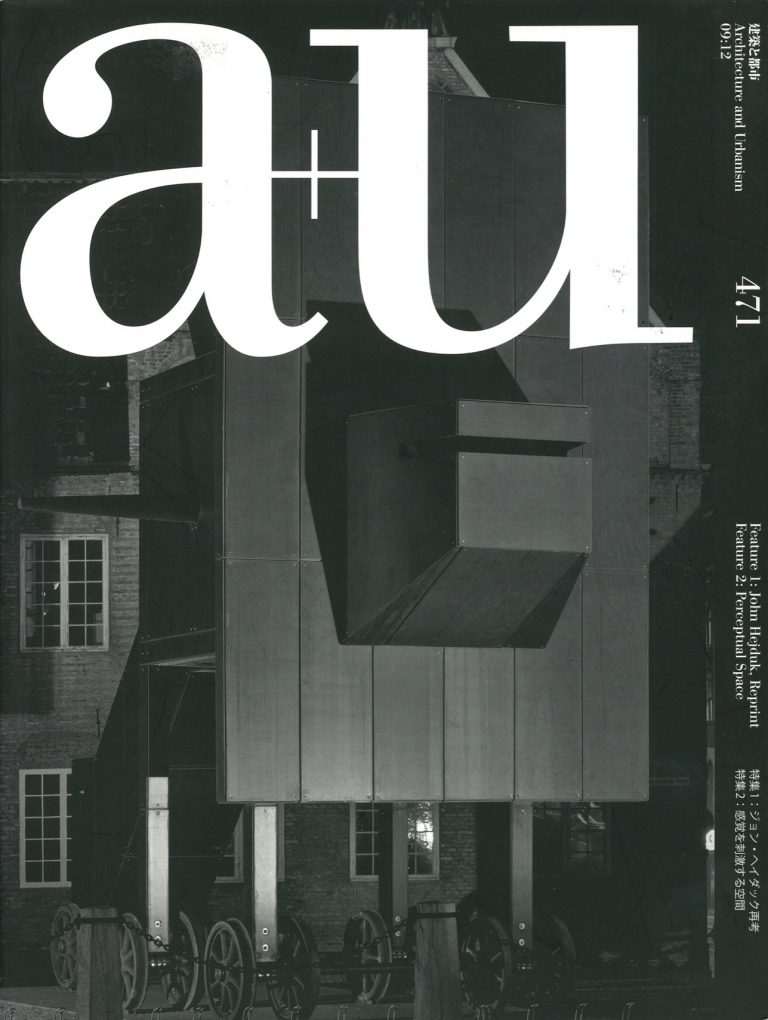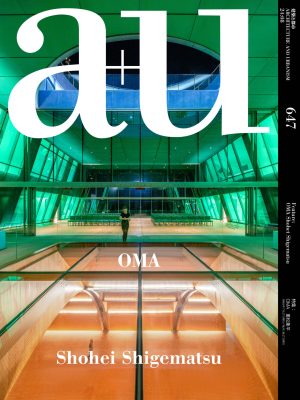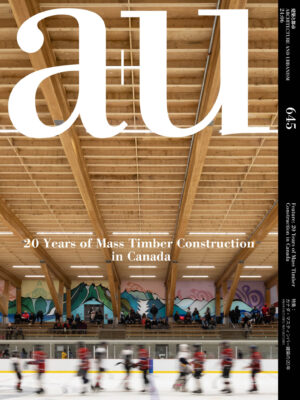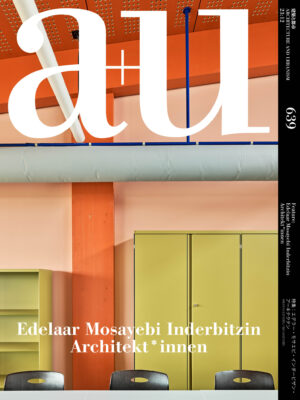a+u 2009:12 John Hejduk, Reprint + Perceptual Space
Content
Cover: OSLO Security by John Hejduk. Photo: Hélène Binet.
Interview:
Shigeru BanWhat I Learned From John HejdukThe Wall House #2REPRINTEditor’s IntroductionEssay by David ShapiroAn Introduction to John Hejduk’s Works: Surgical ArchitectureA Poem for John Hejduk by David ShapiroAfter a Lost Original / The Snow Is Alive / Walter Benjamin: A Lost Poem / In Germany / After Asturiana / You Are Tall and Thin / Prayer For My Son / To My Son / House of The Secret / For VictimsHousingsBERLIN TEGEL
Conversation Between
John Hejduk
and
David Shapiro
:
“The Architect Who Drew Angels”WorksLONDON Collapse of TimeOSLO SecurityRIGAATLANTA The House of The Suicide and The House of The Mother of The Suicide
Essays and Poem by John HejdukArchitecture and The Pathognomic
Evening in Llano
The Sleep of AdamFeature 2 : Perceptual Space One of the defining characteristics of architecture, one that makes it what it is, is that people can touch it and go inside it. It is fair to say that architecture is what it is because it has interior spaces, and that interior spaces exist because of architecture. Also, compared to architecture itself, interior spaces are closer to human bodily perceptions.Recently we are seeing more interior designs that represent crystallizations of interactive relations between people and space. These designs reveal the poverty of the view that regards interiors as nothing more than decoration. Looking outside architecture, we also see a transition away from the previous emphasis on materials and visuals and toward designs that stimulate all five of our senses. Instead of closure as the goal, we see designs that leave something open to explore in the future – an approach that resonates with the recent trend toward sustainability and lessening the burden on the environment.This issue introduces some of the most prominent representatives of this moment in interior design, and examines from a variety of perspectives the fertile relationships between space and human perceptions.We can feel a new wind blowing, one that is bringing not more show but more reality.Naomi ShibataPROJECTSOMA/AMO Spring/Summer 2010 PRADA Men&Women Fashion ShowBackground of Design: Collaboration between OMA/AMO and PRADAJean Nouvel Les Bains des DocksBackground of Design: Formcoating Technology used in Play Area for ChildrenKarim Rashid Chelsea LoftBackground of Design: Karim Rashid UniverseLOT-EK PUMA CITYBackground of Design: Making Mobile BuildingJohn Pawson Monastery of Our Lady of Novy DvurBackground of Design: Detail Drawings of Monastery of Our Lady of Novy DvurFrédéric Flamand
+
Humberto & Fernando CampanaMetamorphosesBackground of Design: To Recycle is to MetamorphosePhilippe Rahm Interior Gulf StreamBackground of Design: Designing Space is Designing ClimateZaha Hadid JS Bach / Zaha Hadid Architects Chamber Music HallBackground of Design: Acoustic Design for JS Bach Music HallMaison Martin Margiela “After Party Show”Background of Design: New Perspective by Maison Martin MargielaZecc Architecten
Church of LivingBackground of Design: Zecc’s Vision on Restoration between Different FunctionsFEATURESSmart SustainabilitySustainable Dance Club / Parupu / 10-Unit System Momentary SpaceHow to Create Fahion Shows / Les Sept Planches de la Ruse / Die Frau ohne Schatten Perceptions of Art Space“we know nothing about space” / Dialogue in the Dark / Flow 5.0 / Dune 4.1FILESNEXT architects
+
Claudia Linders, House M&M 51N4E, WET89 Arkitekturverkstedet i Oslo
/ Asplan Viak
, WeSC Concept StoreSebastian Mariscal, Pio Pio Restaurant Serie Architects, Blue Frog Acoustic Lounge and Studios Office dA, BANQPoint Supreme Architects, Aktipis Flower Shop
Toshiba +
takram
+
Ryo Matsui, OvertureLissoni Associati
+
Highland Associates
+
Erwin Hauer, Elie Tahari Fashion StudioCamenzind Evolution, Google’s new EMEA Engineering HubJ. Mayer H. Architects, positive.negativeUXUS, McVillageMerkx + Girod architects, Bookstore Selexyz DominicanenHeatherwick Studio, La Masion Unique LongchampRyuji Nakamura, Snow/Jin’s Global Standard AoyamaPEOPLERonan & Erwan BouroullecEXHIBITION REPORT“Opening Soon…” Anniina KoivuFeature 2 Editor/Art director: Naomi Shibata












